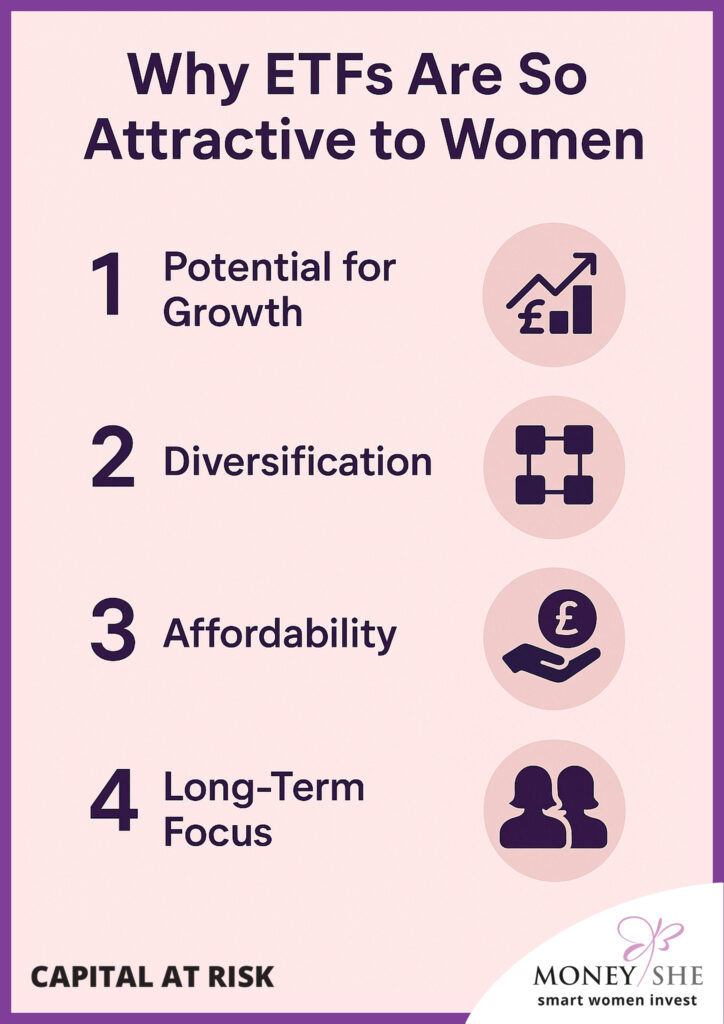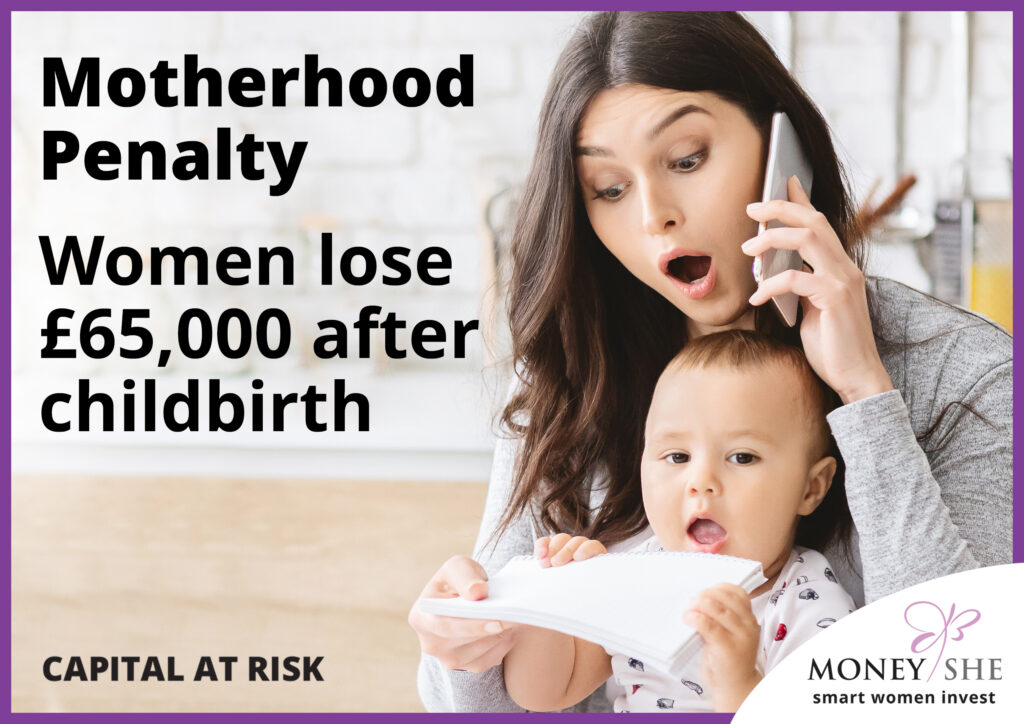14 November 2025
According to a recent survey, 42 % of UK investors say they have begun investing because they recognised that cash savings alone would not grow their money enough to beat inflation and give them a comfortable future.
The research found that younger Brits are turning to investing in Exchange Traded Funds (ETFs) to give their money a better chance of growth than keeping everything in lower yielding savings accounts.
The BlackRock’s “People & Money” study (Nov 2025) shows that new investors in the UK are trending towards investing in Exchange Traded Funds (ETF) with the UK ETF investor base expanding from 1.01 million in 2022 to 2.1 million in 2025 – a 104% increase. Since 2022, ETF adoption among investors in the UK has risen fastest among 25-34-year-olds (+113%) and evenly across all income levels.
In terms of women, 51 % of new investors in the UK over the next 12 months are expected to be women, and many will be embracing the the trend towards ETFs opens a powerful opportunity: rather than simply saving in cash, we can invest with intention whilst also reducing risk and focusing on long‑term financial freedom.
That’s where MoneyShe’s ETF‑only discretionary portfolio service comes in. Let’s explore the advantage of choosing a dedicated professional ETF active manager versus going it alone and DIY investing.
Why ETFs Are So Attractive to Women
ETFs (Exchange-Traded Funds) combine accessibility, diversification, and transparency – an irresistible combination that strongly aligns with what many women love in financial decision-making.
🔹 Diversification without complexity: With even a single ETF, investors can gain exposure to hundreds (or even thousands) of stocks, bonds, or assets. That means less risk from any one company or sector – no need to hand-pick winners.
🔹 Cost-efficiency and transparency: ETFs typically come with low management fees and clear reporting. For women prioritising value and visibility in their finances, this makes ETFs easy-to-understand building blocks in their portfolios.
🔹 Flexibility with control: Unlike traditional mutual funds, ETFs trade like shares, meaning investors can buy or sell during market hours, with no hidden lock-ins. This gives women more flexibility to respond to life changes, like career shifts, and market movements.
🔹 Aligned with long-term thinking: Research shows that women often approach investing with a long-term, goal-focused mindset – which suits the steady, compounding nature of ETFs, especially when part of a managed portfolio.
🔹 Confidence through simplicity: For women newer to investing, ETFs feel less intimidating than jumping into individual stocks. They offer a structured way to enter markets and managing risk.

The Investment Landscape: What the Data Tells Us
Cash is losing buying power as we enter a likely higher and prolonged inflation period. Many UK households have increased savings, but they’re still overwhelmingly in cash. Research by J.P. Morgan shows that half of the recent accumulation of savings is still in cash or cash‑like deposits – and that means being vulnerable to inflation.
UK inflation was 3.8% in the 12 months to September 2025, unchanged from August 2025 and is higher than the rate in many other G7 and Western European nations and the likelihood is that it will rise and remain higher for longer.
The average cash savings rate for the last 12 months has been around 2.59% for easy-access accounts and 3.96% for one-year fixed-rate accounts.
This compares to the MoneyShe Absolute Return Portfolio which has a rolling return for 12 months to 30 September 2025 of 9%. (The value of investments can go down in value as well as up, so you could get back less than you invest. It is therefore important that you understand the past performance is not a guide to future returns.)
Historically, women have tended to invest less or later than men. But according to BlackRock’s ‘People & Money’ research, 51 % of new UK investors over the next year are expected to be women, and 66 % of new ETF investors are aged 18–34.
With increasing interest in investing and heavily marketed DIY investment platforms, younger and first-time investors are lulled into a sense that investing is easy and that they can buy their favourite brands, stocks and shares in companies in the headlines and sit back whilst their money grows.
The reality is that investing is complex, carries risk and DIY investing tends to lead to behavioural pitfalls such as timing mistakes, chasing strategies, lack of research and access to underlying data, and lack of diversification.
That’s where a discretionary manager adds value – especially if they are actively managing your portfolio as research has found that asset allocation can explain up to 90 % of the variability in a portfolio’s returns over time – meaning the mix of stocks, bonds, cash matters hugely.
What is Asset Allocation
Say you have an investment pot of £20,000 to put into a portfolio – asset allocation is about dividing your portfolio into different assets: stocks, bonds, cash. Each asset has different risk and returns and reacts differently to markets.
The job of a professional manager is also to match you to the best asset mix for your risk, goals, and time – whilst also diversifying your portfolio to reduce volatility and improve outcomes. So the asset allocation varies by your factors – age, income, and goals. For example, a young, risk-tolerant woman may favour a different asset allocation to an older, lower-risk, shorter investment timeline.
Some managers offer a ‘buy and hold strategy where the ETFs in your portfolio are only reviewed once every 6 months or 12 months. But in an increasingly volatile, uncertain world, constantly looking at the portfolio and adjusting based on what’s going on in markets is a smarter choice as it allows for regular review and adjustment.
In summary, asset allocation helps you invest well. It diversifies, manages risk, and supports your goals. A systematic approach leading to smart decisions and better performance.
Why MoneyShe: The Advantages of Professional, Female‑Focused Portfolio Management
Here’s how MoneyShe differentiates itself – and why that matters compared with you choosing to do it yourself (DIY approach):
✅ 1. ETF‑only discipline with built‑in diversification
By focusing solely on ETFs, MoneyShe ensures you’re not over‑exposed to individual stock risk or chasing hot tips. ETFs offer broad exposure to markets, sectors or asset‑classes, and trading like a share, they deliver transparency and cost‑efficiency.
✅ 2. Professional monitoring and rebalancing
Even if DIY investors pick a few ETFs, they then leave them dormant. Over time, allocations drift, risk builds up. With a managed portfolio, we continuously monitor, rebalance and adjust to keep your risk‑return profile aligned with your goals, to maximise consistent returns .
✅ 3. Behavioural support and risk‑management
One of the biggest risks for DIY investors is behaviour bias: panic‑selling in a downturn, chasing headline winners after a run, neglecting cash needs, ironing bubbles or falling into sequences of bad decisions.
MoneyShe provides structure, discipline, expertise and support – so you’re less likely to be derailed when things are going down.
✅ 4. Female‑centric insight
We understand many women have unique financial journeys: career breaks, later starts, different risk‑profiles, divorce, lower confidence/knowledge levels, multiple goals.
The MoneyShe model is built around these realities – with clear communication, accessible language, and the reassurance of knowing your investments are being actively managed.
✅ 5. De‑risking through professional oversight
While no investment is risk‑free, having a discretionary manager helps mitigate key risks: concentrating too much in one region/sector, failing to diversify, paying too much in fees, reacting emotionally.
DIY Investing: The Appeal and the Hidden Risks
There’s no doubt that DIY investing has appeal: you’re in control, you can customise, you feel empowered. With the rise of low‑cost brokerage platforms and plentiful online information, many women are taking that route. But there are pitfalls to watch out for.
Pros of DIY:
- You pick every fund or ETF and decide your strategy.
- Potentially lower ongoing fees if you use cheap ETFs and trade yourself.
- Total control and transparency.
But the cons…
- Time and effort: To do it well you must continuously research, monitor markets, rebalance, adjust for tax, account for your changing life circumstances.
- Behavioural risk: Without oversight, it’s easy to drift off plan, get spooked in a downturn, or chase returns after the market has already risen.
- Lack of diversification/structure: DIY portfolios sometimes lean too heavily in one sector, region or theme. They may lack the rebalancing discipline to stay aligned with risk‑tolerance.
- Emotional and cognitive load: Investing can be complex. Making mistakes or delaying decisions costs money over time, especially if you start later.
- Over‑confidence or under‑confidence: Some DIY investors may tire of doing the work, pause contributions, or sit too much in cash when markets fall, which defeats the purpose of market exposure.
- Women’s specific dynamics: data suggests women are more likely to start investing later, take career breaks for caregiving and experience gender pay, divorce and inheritance gaps – leading to them being time poor, having a shorter investment timeline and leading to less time to ‘learn the ropes’. Having a professionally managed solution can help you bridge these gaps more effectively.
Investing with MoneyShe is where professional management meets simplicity.
In Summary – Key Takeaways
This new research shows a meaningful shift as more UK investors realise that savings alone won’t cut it, and that ETFs offer a modern path to market exposure. For women in particular, the move from cash to investment – especially via a trusted, managed solution – is a chance to leap‑frog many of the pitfalls of DIY investing.
- Cash alone may not keep pace with inflation – you lose real value.
- ETFs are gaining traction especially among younger investors and women.
- Asset allocation and portfolio discipline matter more than chasing the latest hot stock.
- Professional, tailored management helps bridge gaps and reduce risk.
- For many women, starting now with a managed ETF portfolio means making your money work harder and smarter.
With MoneyShe, you get a professionally managed, ETF‑only portfolio tailored for women, with diversification, structure, oversight, and a focus on risk‑management – all of which help you convert intent into action, and action into long‑term potential.
Start now. Invest in yourself. Build the financial resilience to thrive, on your terms.
🟣 Join the MoneyShe community today and take the first step toward reclaiming your financial future.
👉 Explore our tools and start investing now
Important Notice:
This is general information only and not financial advice. The value of investments can go down as well as up, so you could get back less than you invest. It is therefore important that you understand the past performance is not a guide to future returns. None of the trading brands of SCM Private, MoneyShe or SCM Direct – give personal advice based on your circumstances. We aim to provide investors with understandable information so they can make fully informed decisions. If you are unsure about the suitability of our investment portfolios, please contact an independent financial adviser.






